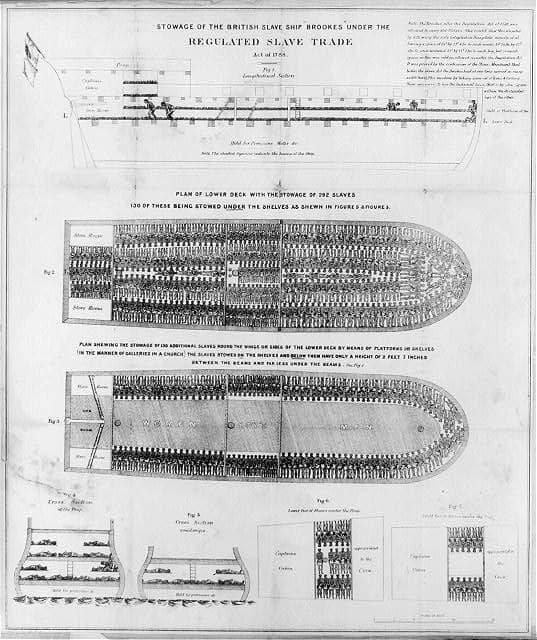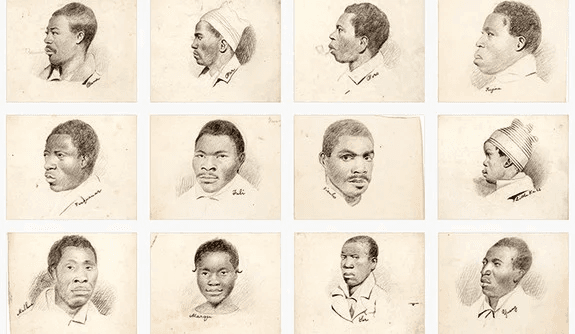African Resistance on Slave Ships and the Antislavery Movement
Ryan Lee
10 min read
Listen to this study note
Study Guide Overview
This study guide covers the Middle Passage, focusing on African resistance methods (hunger strikes, revolts, sabotage) and their impact on the slave trade's economics. It examines the La Amistad Revolt, slave ship diagrams as tools of both oppression and resistance, and their influence on the abolitionist movement. Key sources like the Brookes diagram and Amistad trial sketches are analyzed. The guide also provides exam tips and practice questions covering these topics.
#AP African American Studies: The Middle Passage & Resistance - Study Guide
Hey! Let's get you prepped for this exam. We're going to break down the Middle Passage and African resistance, making sure you're not just memorizing facts, but understanding the big picture. Think of this as your ultimate cheat sheet! 😉
#
The Horrors of the Middle Passage & African Resistance
#African Resistance on Slave Ships
-
The Middle Passage wasn't just a passive journey; it was a battleground. Enslaved Africans actively fought for their freedom in many ways.
-
Methods of Resistance:
- Hunger Strikes: A powerful form of protest, both individually and collectively, against the trauma of being uprooted and enslaved. 🙅🏾♀️
- Jumping Overboard: Choosing death over a life of bondage, highlighting the desperation and resilience of enslaved people.
- Coordinated Revolts: Overcoming language barriers to organize uprisings, demonstrating unity in the face of oppression. ✊🏾
- Sabotage: Damaging ship equipment to disrupt operations and assert agency.
- Work Slowdowns & Feigned Illness: Disrupting the daily routine of the ship to reclaim some control.
-
Impact of Resistance:
- Increased Costs: Enslavers faced higher expenses due to damaged goods, lost labor, and the need for more security. 💰
- Heightened Dangers: Crew members were constantly at risk of revolts and physical harm. ⚠️
- Changes in Ship Design: Barricades, nets, and more weapons were added to suppress resistance. 🚢
La Amistad Revolt:**
* **1839:** More than 30 years after the abolition of the slave trade, highlighting the persistence of illegal trafficking.
* **Led by Sengbe Pieh:** A Mende captive who galvanized others to fight for freedom. 💪🏾
* **Successful Takeover:** The enslaved Africans took control of the ship, a major victory.
* **Legal Battle:** A two-year fight that ended with the Supreme Court granting the captives their freedom. ⚖️
* **Public Sympathy:** Exposed the cruelty of the slave trade and fueled the abolitionist movement.
Practice Question
Multiple Choice Questions
-
Which of the following was NOT a common method of resistance used by enslaved Africans on slave ships? a) Hunger strikes b) Jumping overboard c) Negotiating with the crew d) Sabotage
-
The La Amistad revolt is significant because it: a) Led to the immediate end of the transatlantic slave trade. b) Demonstrated the legal rights of enslavers to their human property. c) Resulted in a Supreme Court decision granting freedom to the enslaved Africans. d) Was a typical example of how most slave revolts ended.
Short Answer Question
Briefly explain two ways in which African resistance on slave ships impacted the economics of the transatlantic slave trade.
Free Response Question
Analyze the various methods of resistance employed by enslaved Africans during the Middle Passage and discuss how these acts of resistance influenced the design of slave ships and the broader abolitionist movement. In your response, consider the following:
- Specific examples of resistance
- The impact of resistance on the economics of the slave trade
- How resistance influenced the design of slave ships
- The role of resistance in inspiring the abolitionist movement
Scoring Breakdown
- Methods of Resistance (2 points):
- 1 point for identifying at least two distinct methods of resistance (e.g., hunger strikes, revolts, sabotage).
- 1 point for briefly explaining how these methods were used.
- Impact on Economics (2 points):
- 1 point for explaining how resistance increased costs for enslavers (e.g., damaged goods, lost labor).
- 1 point for explaining how resistance increased dangers for crew members.
- Influence on Ship Design (2 points):
- 1 point for identifying at least two changes in ship design as a result of resistance (e.g., barricades, nets).
- 1 point for explaining the purpose of these design changes.
- Inspiration for Abolitionism (2 points):
- 1 point for explaining how resistance fueled the abolitionist movement.
- 1 point for providing an example of how resistance was used by abolitionists.
- Clarity and Analysis (2 points):
- 1 point for clear and organized writing.
- 1 point for demonstrating a strong understanding of the relationship between resistance and its consequences.
#Features of Slave Ship Diagrams
-
Slave ship diagrams weren't just neutral drawings; they were tools of oppression and later, of resistance.
-
Systematic Arrangement of Captives:
- Profit-Driven: Designed to maximize the number of enslaved people in a limited space. 💰
- Packed Tight: Captives were crammed together, prioritizing efficiency over humanity. 📦
- Underrepresentation: Often showed only about half the actual number of people on board. 🤫
- Arrangement by Demographics: Based on age, gender, and size to maintain control.
- Minimizing Movement: Placed to prevent communication and organization.
-
Unsanitary Conditions Depicted:
- Cramped & Filthy: Facilitated the spread of disease. 🦠
- Poor Ventilation: Leading to suffocating conditions. 🥵
- Lack of Sanitation: Forcing captives to live in their own waste. 🤢
- Scarcity of Resources: Minimal food and water, leading to malnutrition and dehydration.
- Inhumane Treatment: Chained and given minimal space to move or rest.
Omission of Anti-Resistance Features:**
* **Rarely Included:** Measures used to suppress resistance (guns, nets, etc.).
* **Omitted Weapons:** Guns and other tools used to intimidate and subdue captives. 🔫
* **Failed to Depict Nets:** Placed to prevent captives from jumping overboard. 🕸️
* **Excluded Iron Instruments:** Used to force-feed captives on hunger strikes. 🥄
* **Ignored Crew Placement:** Strategic positioning to minimize contact between captives and crew.
#Influence of Resistance and Diagrams
-
These elements didn't just stay in the past; they became powerful tools for change.
-
Inspiration for Abolitionists:
- Catalyst for Activism: Fueled the antislavery movement. 🔥
- Tangible Evidence: Showed the horrific conditions of the Middle Passage. 💔
- Public Awareness: Black and white abolitionists used diagrams to raise awareness. 📣
- Humanizing the Enslaved: Generated empathy for the suffering of enslaved Africans. 🫂
- Growing Momentum: Contributed to the eventual end of the slave trade.
-
Repurposing of Slave Ship Imagery:
- Processing Trauma: Black artists used the images to confront the past. 🎭
- Honoring Memory: Remembering the 12.5+ million Africans who were forcibly transported. 🕯️
- Symbol of Resilience: Reclaimed the iconography as a symbol of strength and resistance. 💪🏾
- Transformation: From oppression to remembrance and celebration. 🎉
- Artistic Mediums: Incorporated into paintings, sculptures, and installations to explore themes of identity and diaspora.
Practice Question
Multiple Choice Questions
-
Slave ship diagrams are often criticized for: a) Accurately depicting the number of captives on board. b) Highlighting the humane treatment of enslaved Africans. c) Omitting anti-resistance features and underrepresenting the number of captives. d) Showing the excellent living conditions of the crew.
-
How did abolitionists use slave ship diagrams? a) To demonstrate the efficiency of the slave trade. b) To show the economic benefits of slavery. c) To raise public awareness about the inhumane conditions of the Middle Passage. d) To encourage people to invest in the slave trade.
Short Answer Question
Explain how slave ship diagrams both reflected and obscured the realities of the Middle Passage.
Free Response Question
Analyze how slave ship diagrams were used as tools of both oppression and resistance. In your response, consider the following:
- The systematic arrangement of captives and what it reveals about the priorities of enslavers
- The unsanitary conditions depicted and their impact on the lives of enslaved Africans
- The omission of anti-resistance features and what this implies
- How abolitionists and artists repurposed these diagrams to fight against slavery and honor the memory of the enslaved
Scoring Breakdown
- Systematic Arrangement (2 points):
- 1 point for identifying how the diagrams showed the arrangement of captives.
- 1 point for explaining what this arrangement revealed about the priorities of enslavers.
- Unsanitary Conditions (2 points):
- 1 point for describing the unsanitary conditions depicted in the diagrams.
- 1 point for explaining the impact of these conditions on the lives of enslaved Africans.
- Omission of Anti-Resistance Features (2 points):
- 1 point for explaining what was omitted from the diagrams regarding resistance.
- 1 point for analyzing what this omission implies.
- Repurposing of Diagrams (2 points):
- 1 point for explaining how abolitionists used the diagrams.
- 1 point for explaining how artists repurposed the diagrams.
- Clarity and Analysis (2 points):
- 1 point for clear and organized writing.
- 1 point for demonstrating a strong understanding of the dual role of diagrams.
#Required Sources: A Closer Look
#Stowage of the British Slave Ship Brookes, Early Nineteenth Century

- Visual Impact: A powerful depiction of the inhumane conditions of the Middle Passage.
- Human Cargo: Shows how enslaved Africans were treated as cargo, not people.
- Abolitionist Tool: Galvanized public opinion against the slave trade.
#Plea to the Jurisdiction of Cinque and Others, 1839
- Legal Challenge: A crucial document from the Amistad case, challenging U.S. court jurisdiction over the enslaved Africans.
- Assertion of Freedom: Highlights the captives' claim to freedom and their right to resist enslavement.
- Legal Advocacy: Underscores the importance of legal battles in the fight against slavery.
"The said Respondents severally, by protestations not confessing or acknowledging any of the matters & things in said several (inserted) libels to be true, as therein alleged, for plea thereto respectively say - That they are severally natives of Africa and were born free, and ever since have been, and still of right are and ought to be free, and not slaves, as in said several libels pretended, or surmised – that they were never domiciled in the Island of Cuba, or the dominion of the Queen of Spain, or subject to the laws thereof; – that on or about the 15th day of April 1839 they and each of them were, in the land of their nativity, unlawfully kidnapped & forcibly and wrongfully carried on board of a certain vessel, near the coast of Africa then & there unlawfully engaged in the slave trade, by certain persons to them unknown, and were thence in said vessel contrary to the will of these respondents, unlawfully transported to the Island of Cuba for the unlawful purpose of being there sold as slaves, and were then illegally landed for the purpose aforesaid..."
#Sketches of the Captive Survivors from the Amistad Trial, 1839

- Humanizing Resistance: Provides a visual record of the Amistad captives who fought for their freedom.
- Primary Source: Offers insight into their appearances and cultural identities.
- Educational Tool: Illustrates the complexities of the slave trade and the agency of enslaved Africans.
#Stowage by Willie Cole, 1997

- Modern Interpretation: Uses repurposed steam irons to evoke the brutal history of the slave trade.
- Visual Metaphor: Connects past atrocities to present-day domestic life and labor.
- Legacy of Slavery: Highlights the ongoing impact of slavery on African American experiences.
#
Final Exam Focus
-
High-Priority Topics:
- Methods of resistance on slave ships (hunger strikes, revolts, sabotage).
- The impact of resistance on the economics of the slave trade.
- The La Amistad revolt and its significance.
- Features of slave ship diagrams and their dual role as tools of oppression and resistance.
- The influence of resistance and diagrams on the abolitionist movement.
-
Common Question Types:
- Multiple-choice questions testing your knowledge of key events and concepts.
- Short answer questions requiring you to explain specific aspects of the Middle Passage and resistance.
- Free-response questions asking you to analyze the significance of resistance and the impact of slave ship diagrams.
Last-Minute Tips:
** * Time Management: Pace yourself and don't spend too long on any one question. * Read Carefully: Pay close attention to the wording of each question. * Connect Concepts: Look for connections between different units and themes. * Use Evidence: Support your answers with specific examples and details from the sources. * Stay Calm: Take deep breaths and trust in your preparation. You've got this! 💪🏾
Remember the key themes with this mnemonic:
Resistance: Africans fought back in many ways. Economics: Resistance impacted the slave trade financially. Diagrams: Slave ship diagrams were tools of oppression and resistance. Abolition: Resistance and diagrams fueled the fight against slavery.
RED A will help you remember the core concepts. 😉
Let's do this! You are ready to rock this exam. 🚀
Continue your learning journey

How are we doing?
Give us your feedback and let us know how we can improve





